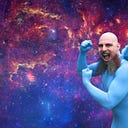Ask Ethan #49: Do the cosmic unknowns cast doubt on the Big Bang?
We don’t know the nature of either dark matter or dark energy: 95% of our Universe. Does that mean the Big Bang is in doubt?
Image credit: wiseGEEK, © 2003 — 2014 Conjecture Corporation, via http://www.wisegeek.com/what-is-cosmology.htm#; original from Shutterstock / DesignUA.
“Whenever you have infinities in a theory, that’s where the theory fails as a description of nature. And if space was born in the Big Bang, yet is infinite now, we are forced to believe that it’s instantaneously, infinitely big. It seems absurd.” -Janna Levin
It’s a wonder, in some ways, that with all we’ve come to know, through all our investigations, we still run up against questions that we simply can’t answer. Each week, you do your best to stump me in our weekly Ask Ethan column, by sending in your questions and suggestions, knowing I’ll pick my favorite to address. This week’s entry comes from jlnance, who asks:
Scientists are fairly confident that they understand the evolution of the universe right back to the very instants before the big bang. They are also confident that the universe is composed largely of dark matter, whose composition is unknown, and it’s dynamics are dominated by dark energy, which is also not well understood (is it a new force?)
How is it possible to extrapolate back to the big bang, when so little of the matter and force in the universe is understood?
This is an important point worth considering whenever we acquire new knowledge: is our old way of thinking still valid? Let’s find out.
We can start by reminding ourselves where the idea of the Big Bang first came from. There were a few important events that happened historically, laying the foundation for the understanding we’d come to develop, and they are the following:
General Relativity — a new theory of gravity — was developed and had its new predictions confirmed. Originally designed so that it would resolve the problem of Mercury’s orbital precession around the Sun, it also predicted a whole host of phenomena that have since been confirmed, including the deflection of distant starlight by intervening masses, gravitational redshifts, a time-delay due to gravitational effects, the orbital decay of very close masses to one another, and many more.
Galaxies were determined to be objects outside our own Milky Way. Originally thought to be nebulous, star-forming regions only a few thousand or tens-of-thousands of light-years away, the combination of very large observed speeds (which would render them gravitationally unbound from our Milky Way) and, later, the identification of individual stars within them taught us that they must be many millions of light-years distant.
The galaxies in the Universe — discovered to be roughly uniformly distributed in all directions and at all distances — were determined to be expanding away from us. By combining the redshift data, of how fast these galaxies were moving away from us, with the distance data, which we were able to obtain from observations of stars within each individual galaxy, gave rise to Hubble’s Law, which established that in general, the farther away a galaxy was from us, the faster we could expect to find it moving away from us.
When combined with the viable solutions to General Relativity, this led not to a Universe where all the galaxies were speeding away from us, like an explosion centered on our location, but to a Universe that was expanding, with new space constantly being created between galaxies, forcing them apart. For those of you wondering about the more technical aspects of this, all isotropic, homogeneous spacetimes (that is, solutions to GR that are roughly the same at all locations in space and in all directions) must either have expanding or contracting space.
One possible consequence of this, although it isn’t the only possibility based on what we’ve stated so far, is that the Universe was denser and hotter in the past, and that will cool and become sparser as time goes forward. This idea, mind you, is the Big Bang. What this implies is that the Universe is expanding today — that light is more significantly redshifted the farther away you look — because the Universe was hotter, denser and younger in the past.
Wavelengths of light were shorter, and hence the Universe was more energetic back then. Additionally, matter-and-radiation was closer together, and so collisions back then not only packed a bigger punch, but happened more frequently. If this were true, then there would be some tremendous consequences for our Universe on account of this idea.
1.) The Universe was more spatially uniform in the past. Because gravitation is a runaway force — the more mass you get together, the greater the force of attraction is in any particular region — that means the Universe is right now more “clumpy” than at any time before. But this also means that there was a time when there weren’t superclusters of galaxies, when there weren’t galaxies and even, if we go back early enough, where there weren’t individual stars. This means that not only would there be only tiny differences in density between the most dense and the least dense regions in the Universe when it was younger, but that all the heavier elements that were created in stars would not have existed in the distant past.
2.) It was once so hot that neutral atoms couldn’t form. If you allow collisions between photons and atoms to be frequent enough and energetic enough, you’re going to kick the electrons right off of any neutral atoms. If we extrapolate back early enough — to when the Universe was hot-and-dense enough — it would have been impossible to form any neutral atoms without them immediately becoming ionized by another incoming photon. And finally,
3.) It was even once so hot that we couldn’t even form atomic nuclei. Even though the forces binding nuclei together is many orders of magnitude stronger than the forces binding atoms — by a factor of around a million — there’s nothing stopping the Universe from being arbitrarily hotter and denser in the past. If this is true, then there was a time when the Universe was just a sea of protons, neutrons and electrons, and cooled through a stage where the protons and neutrons could fuse together without being blasted apart. This should result in the fusion and formation of specific amounts of the lightest elements and isotopes — deuterium, helium-3, helium-4 and lithium-7 — but not much else. That amount and ratio should be dependent solely on the ratio of baryons (protons and neutrons) to photons present in the Universe.
If you have normal matter (protons, neutron and electrons) in your Universe along with radiation, and the Big Bang is correct, we’ll see evidence of all three of these things. In particular, there will be a leftover glow of radiation from the earliest stages of the Universe: almost perfectly isotropic and homogeneous, and just a few degrees above absolute zero.
There will also be clouds of gas out there that are pristine: having never formed stars since the Big Bang, and we should be able to detect the amounts of those trace elements and isotopes from those earliest stages.
And finally, we should see fluctuations in that leftover glow from the Big Bang, but those fluctuations should be tiny in magnitude.
Additionally, we should see evolution in the structure and chemical composition of the Universe, with older, closer regions consisting of greater clumpiness and a greater density of heavier elements.
The Big Bang wouldn’t be accepted if we didn’t see all of these things, and we do. No other theory or model predicts these things or can rival the Big Bang for that kind of success.
But the original question still stands: the Big Bang didn’t predict dark matter or dark energy. Does that pose a difficulty?
All of this — the whole story I outlined above — would be true regardless of what else is actually in your Universe. The only things that change due to dark matter and dark energy are the following:
Dark matter impacts the subtleties of structure formation. In particular, because it clumps like matter does but doesn’t interact via collisions with either itself, normal matter or radiation, it quantitatively changes the magnitude and number of small galaxies, large galaxies and how their clustering works. It also affects the spectrum of fluctuations going all the way back to the cosmic microwave background.
But even with five times as much dark matter as normal matter, the rest of the story is unchanged.
Dark energy, on the other hand, only affects the rate of cosmic expansion at late times. While there was evidence of dark matter going back to 1933, it’s no wonder that people didn’t begin to seriously consider a Universe with dark energy until the 1990s: you need to have very precise measurements of distance indicators in the Universe going out to around ten billion light-years to even begin to see its impacts.
So even though dark matter and dark energy make up huge fractions of the energy content of our Universe — dark matter at about 26% and dark energy at around 69% — they don’t pose any difficulties for the Big Bang.
In principle, the Universe could have included any or all of the following (sorted in order from highest positive pressure to lowest negative pressure):
- radiation in the form of massless particles (e.g., photons),
- neutrinos,
- normal matter (e.g., protons, neutrons and electrons),
- dark matter,
- point-particle topological defects (e.g., magnetic monopoles),
- cosmic strings,
- intrinsic spatial curvature,
- domain walls,
- cosmic textures,
- a cosmological constant,
- and/or dark energy that violates the weak energy condition, leading to a “Big Rip” fate for our Universe!
We have radiation, neutrinos and normal matter; we’ve known that for nearly a century. But of all the other things? It looks like we have dark matter and a cosmological constant as our particular form of dark energy, and that’s it.
If you look at it from the perspective of “well, the Big Bang didn’t predict that,” you might be annoyed, but the Big Bang isn’t the final answer to the Universe, it’s just part of the story!
There’s always more to learn, and so cosmic inflation, dark matter and dark energy don’t pose a problem for the Big Bang, they simply show us what the limits of the Big Bang are as far as teaching us the full story about our Universe.
Thanks for a great Ask Ethan, and if you’ve got questions or suggestions for me, send them in; the next column could be yours!
Leave your comments at the Starts With A Bang forum on Scienceblogs!

